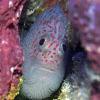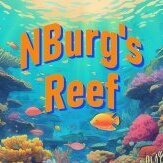
gws3
WAMAS Member-
Posts
1,192 -
Joined
-
Last visited
Custom Fields
-
Gender
Male
-
Location
Baltimore
Recent Profile Visitors
7,033 profile views
gws3's Achievements

Legendary Reefer (11/13)
-
oceangardenreef started following gws3
-
probably milka stylo
-
Do you have a mesh lid? If not, you'll want to get one first. Wrasses will eventually jump out if not. I second that Melanurus are going to get too big for a 40. They're very active swimmers too. I had a big one in a 8' x 4' tank and he patrolled the whole thing every few seconds. Leopards I don't have experience with, but I believe they need a deep sand bed for long term success. Six line are hit or miss with aggression. I like the recommendation of Lubbocks for a 40. That's a pretty, small and peaceful fish. Any smaller Cirrhilabrus species would likely be a good choice for you.
-
Cyanobacteria. Siphon it out the best you can. Then use a powerhead to blow off the detritus on the rock. Bump up flow in that area slightly. See if it comes back before doing anything else. Patches like this are often caused by an area where detritus has settled and the flow is weak.
-
Need advice - algae and cyno; nitrate 0, phosphate 0.3
gws3 replied to Kathryn Lawson's topic in General Discussion
Chemiclean is an antibiotic. There are plenty of folks who have used it without issues, but something that indiscriminately kills both good and bad bacteria could have harmful effects. It may kill the cyano, but it's unklikely that it will fix the underlying issue that's allowing cyano to fluorish. What the OP has is not a deep sand bed. It's a shallow bed of very coarse material. The do not function the same way. I agree with you deep sand beds don't seem very common anymore. It's better to do a number of small water changes vs one large one. I wouldn't go over 50%. More importantly make sure your new water is similar ph, salinity, temp and alkalinity. Also that it's well mixed. 24 hrs with a strong powerhead should be fine. I'd be more worried about a sudden change to one of those parameters than boosting Ca or Mg quickly. -
Need advice - algae and cyno; nitrate 0, phosphate 0.3
gws3 replied to Kathryn Lawson's topic in General Discussion
I think you've done a good job getting your nutrients at a better level. Keep up with the WC's and the phosphates should keep coming down. Definitely change your salt. No decent salt should be mixing up with Ca and Mg so low. You definitely want to get those up. Ca in the 420-450 range. Mg I like to run elevated at 1400-1500, I strongly believe this will help prevent some of the algae growth. IO or RC would both be a big improvement over you current salt if your test results are correct. How attached are you to your shallow "sand" bed? When I look at your tank pics the impression I get is you have a low flow area at the bottom where detritus is collecting. This is likely be fueling your algae and cyano growth. Personally I would remove the sand bed. This will allow detritus to collect in certain areas on the bottom glass where you can siphon it out regularly. Do you have a pressure washer? I'd be removing a piece of live rock every few days and pressure washing it to combat the algae. Just one piece at a time so bacteria can re-establish. Longer term, if the tank is too small to add an aggressive herbivore/grazer like a tang, you're going to need more clean up crew to keep the rock clean IMO. I'd add something like 30 astrea snails and 50 mexican hermits. Reeftopia or Salty Bottom Reef are good sources. One or two snails aren't going to move the needle with how much algae you have. I liked Nikki's post #21. I would take this tank back to absolute basics. You could probably run this tank's chemistry successfully with just water changes. Add some clean up crew and keep removing algae/cyano manually. You could treat the cyano chemically, but this is a band-aid fix IMO. I think you've got a big nutrient sink at the bottom of the tank and not enough clean up crew. You flow is probably on the low side based on the type of corals you're keeping, so there's not enough flow to keep the detritus suspended in the water column and get it to your sock & skimmer. This is where running bare bottom would really help out. -
Salinity checking journey - finally landed on TM Hydrometer
gws3 replied to Gatortailale's topic in General Discussion
Look at the Hanna HI98319, it'll give you the tenth of a ppt you're looking for. Mine consistently reads 0.8-1.1 lower than the TM hydrometer, but it's consistent. What you could do ii check the HI98319 against the hydrometer every month or two, but use the HI98319 regularly. It can be used in tank, so it doesn't require any saltwater to be removed. -
Salinity checking journey - finally landed on TM Hydrometer
gws3 replied to Gatortailale's topic in General Discussion
Oh, and for temp probe calibration I use another old school device... a mercury filled glass thermometer. Forget the brand, but it meets ASTM 17F. Never requires calibration and it'll never change. Just have to handle it carefully. Also, they're difficult to acquire as they can't be shipped to Maryland due to the Mercury. Not sure if the same rules apply in Virginia. -
Salinity checking journey - finally landed on TM Hydrometer
gws3 replied to Gatortailale's topic in General Discussion
I reached the same conclusion as you Craig, I'm using a TM hydrometer as my most trusted source for salinity measurements. It was the clear winner after years of struggling with optical refractometers and never really trusting the conductivity based ones. I use about 400 ml in a 500 ml plastic graduated cylinder. Drop it in, spin, and check it in a minute or two when it settles. When I check salinity I also use a Hanna HI98319 tester (conductivity) as well. The Hanna typically reads about 0.8-1.1 ppt lower. I'm not sure why it reads so much lower, it does this regardless of calibration. When I got the TM hydrometers I even went as far as to make a standard with Morton's Iodized Salt per some articles Randy Holmes Farley wrote. At 77F the solution should be 1.0266. One TM hydrometer reads spot on at 1.0266, the other reads at 1.0264. So, very happy with the accuracy of them. The Hanna probe reads about 1.0-1.1 ppt low in this standard I created. -
20mg per gallon. The capsules are 200mg, so 1 capsule per 10 gallons.
-
DaJMasta is giving you good advice. It definitely looks like Bryopsis to me as well. Keep your magnesium elevated where you have it currently (1400-1500) and dose Fluco. 20mg per gallon. For the first three days let your skimmer cup drain back to tank. If you do water changes within the first few weeks dose the new water with Fluco at 20mg per gallon. This problem will most likely clear up within a few weeks doing so and you'll be really happy you didn't do something more drastic. This is where a lot of folks bought fluco before it was being branded for reef tank use, FWIW: https://payless-petproducts.com/fish-fluco-forte
-
husbwifereefer started following gws3
-
Zac Cannizzo started following gws3
-
Nhatnguyen1905 started following gws3
-
monkiboy's 450g display + 250g fish room
gws3 replied to monkiboy's topic in Dedicated Tank (Build) Forum
Awesome build thread, thanks for sharing. I really enjoyed the construction pics, it’s not too often someone can make such significant changes to their home to accommodate their reef system plans. Now for my feedback / criticisms since you asked for it! All of this is from firsthand experience / lessons learned / things I could have done better in my own reefing career. Rockwork: I’m loving the very dynamic rockwork with the towers extending all the way up and all the overhangs and swimming channels for the fish. For some of the more aggressive structures, specifically the cantilevers overhangs, relying on BRS super glue gel and two-part epoxy would make me nervous. I believe the bond of the cyanoacrylate weakens over time. It could be organics developing at the glue/rock interface. I have some pieces of rock glued together in this manner and after a while it doesn’t take much force to cause the joints to fail. I would reinforce the critical joints with the mortar kit from Marco rocks. Eventually you’ll have an encrusted acro or something else on the rock you want to scrape off and you’ll need to put some force against it. That last thing you want is your rockwork covered in Acro colonies to break loose. I’ve had it happen with the exact method you’re using, and it can be very difficult and frustrating to get it back together correctly. Not saying you’re going to break a glass panel or anything catastrophic like that if it happens, it’s just very hard to get the rock back together. In my 425XL I have a very aggressive cantilevered overhang and used the mortar kit for this purpose. two-part epoxy and super glue just wouldn’t have been strong enough and held long term. I can’t remember if I did it with the tank full or dry. I think it was full. I suspect you have rock too close to the front glass. When I aquascaped my 300 I used too much rock and would have used less if I could do it over again. Now I have certain places where the magnetic cleaner can’t fit between the tabling acros and the glass. If I did it again, I’d keep 6-8 inches of a gap. I also used 100% dry marco rock on my 300. It took 18 months for SPS to look decent and two years before they were keeping ideal colors. I don’t know if it took that long for a good bacteria population, the rock was leeching phosphate or something else, or what the cause was. I didn’t use much in the way of bacteria additives. This was 8 or 9 years ago, I don’t think we had as many good options for bacteria additives then. Definitely give some thought to a plan for getting micro biodiversity established earlier. I know you’re more patient than me, but 2 years felt like forever! Sandbed: I echo your thoughts in an earlier post about gluing together the majority of the sandbed. All my tanks except for one are bare bottom. The one tank with substrate is such a pain. It’s a detritus trap. Grows cyano in patches as a result. I use a coarse aragonite media and it’s shallow. Maybe that’s the problem, needs to be sand and deep? But it still gets blown around even with medium flow. Siphoning it is a pain. It will be especially difficult in a large tank like yours without front accessibility. Probably something you’re just going to have to live with since you need something for your wrasses. I’m not sure what wrasses you’re keeping, I keep plenty of Cirrhilabrus without any sand. But I know for some other types a sand bed is a hard requirement. UV: I’m interested to see what impact your giant UV has long term and why you’re using one. Overtime I’ve taken all UV off my systems and I haven’t seen any impact. But they were probably all undersized for the water volume, at least compared to this beast you’re using. I do think they are beneficial to keeping fish disease in check during early stages of stocking. Also, they’re probably useful during ugly phases such as dinos, etc. I’m curious what you think the long-term benefits are. Lighting: I definitely like what you picked with the radion blue / reefbrite XHO combo. I run this combo on a lot of my tanks. Corals love this light combo and look great under it. Where I’d strongly recommend you make a change is how you’re laying them out. The marketing with many modern LED fixtures is misleading in my honest opinion. They embellish on the area one fixture can cover. When LED fixtures were first coming out, they were advertised as being a replacement for a 250W halide in a large reflector. They simply do not have the intensity or the spread in reality. When I replaced 250W radiums with radions it took 2 XR30s or 4 XR15 in each location I replaced one halide. I would say two XR30s exceeds the output of a single halide, but a single xr30 falls far short of matching the coverage of a halide. I read somewhere a G6 XR30 can cover 4 feet. I think that’s absolute rubbish. The G5 (and I assume G6) optics are very impressive with how far they can spread light, but it’s at the cost of intensity. As a result, you have to hang them very low (6-8 inches above the water). I know there are folks that hang them high and are very disappointed with the peak PAR. The amazing spread requires them to be hung low. What I don’t like about your layout is trying to get a single XR30 to cover 3’ front to back. You are going to get a lot of shadowing on the front of rockwork just a result of geometry. Once you get acros in there the corals on the bottom are going to be shadowed by the ones above even if they’re staggered. I probably need to draw a picture to better communicate my thought. What I recommend is a grid of 2 XR30s front to back but 4 XR30s from left to right (a total of 8). And stick with your current amount of reefbrites, I think having four from to back is plenty assuming you’re using XR30 blues (not pros). Accessibility: From the front everything looks super clean and modern. I wonder if not having any access from the front is going to make things really difficult. Mounting a coral and then running around to the other side to make sure it looks good. Also, siphoning the detritus. What about cutting an access hole and covering it with a metal print on a hinge? I’d suggest finding a way to raise and lower the light racks easily. On my 300 I can barely get my arm in the tank due to having to mount the radions so low. Spares: Do you have a spare of those fancy Abyzz pumps? I remember JF was telling me he got rid of all his high-end bubbleking skimmers because a pump broke and a replacement had a long cost and lead time. I know they’re expensive, but the return pump is probably the most important piece of hardware on the entire system. I believe you’re using the Abyzz because you need the head pressure to push up to the next floor? If one fails and you don’t have a backup it may take a while to get one, and you may not be able to find a temporary pump locally that can push that amount of flow up to the next floor. CO2: I worry about CO2 build up and low pH with the tank room and filter room being closed off. I know you sent back the 8000 skimmer and got a 6000. Honestly, I didn’t hate the oversized skimmer for CO2 rejection like you suggested in an earlier post. Do you plan to plumb the 6000 air intake to the outdoors? Roughly speaking this will raise pH by 0.1 in my experience. I run mine through a large carbon block (the type they use for growing pot indoors) just in case something nasty is in the air. I monitor CO2 using a 5V CO2 sensor and a PM2 module. I’m in a ~1400 sq ft basement and just me being down there will cause CO2 to go up. I pump in (through a carbon block) and exhaust a lot of fresh air for the purpose of temp/humidity control and to keep CO2 from accumulating too high. I think it has a significant impact. Perhaps you could leverage that window for some fresh air exchange? Ok, that’s all I have for now. I see so many things that I think you’re doing great with and this build is going to turn out exceptionally without a doubt. But rather than just post a bunch of comments agreeing with what you’re already doing I wanted to focus on feedback based on my firsthand experiences and things I would have done differently in my reefing career. Hopefully it’s helpful! -
Datgsxrboi started following gws3
-
Very cool and thanks for sharing. I have not witnessed any spawning events in any of my systems recently, but I believe it typically happens at night and I can't say I've been checking with a flashlight either. So I'm probably missing all sorts of events, haha. I have seen developing gametes when I frag SPS before. They look like small red or brown eggs, one per polyp, located pretty deep down in the corallite at the base of the polyp. I imagine the stress of being bagged and changing systems caused release of the gametes in this situation. Almost all my tanks are in the basement (natural sunlight minimal) and I run a fixed photoperiod, so I'm not sure there are any other triggers that would cause release. I am glad to see my coral are healthy enough to support spawning events, makes me happy!
-
A couple ways to bump ph up is to plumb skimmer intake to the outdoors. This shifts ph up .1 IME. Also, drip Ca Rx effluent into skimmer intake if you're not already. Sounds like you got a plan. Happy to help. Hopefully your issue improves.
-
Manual removal and algae eaters are likely what's needed. You could try to strip the water of po4 to starve the algae. But in the end you need something that out competes or eats the algae before it gets out of hand. Zero po4 may starve out the algae, but it would also starve the corals. And as soon as nutrients are added existing algae will take it up faster than corals. Another option would be one of those bacteria based products. Like Vibrant. I think the idea is the bacteria out competes the algae by consuming all the nutrients. But I don't have experience with these types of products.
-
Crazy how much CO2 is produced by burning propane/nat gas, right? Years ago I put a ventless propane space heater in my basement. Within a couple hours my APEX was going nuts with alarms and my pH levels had plummeted. Those ventless heaters should definitely not be installed inside homes in my opinion.







